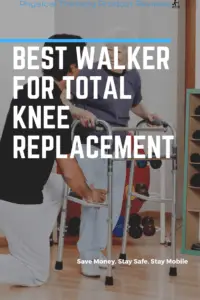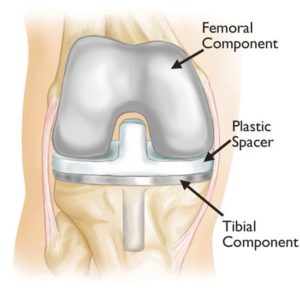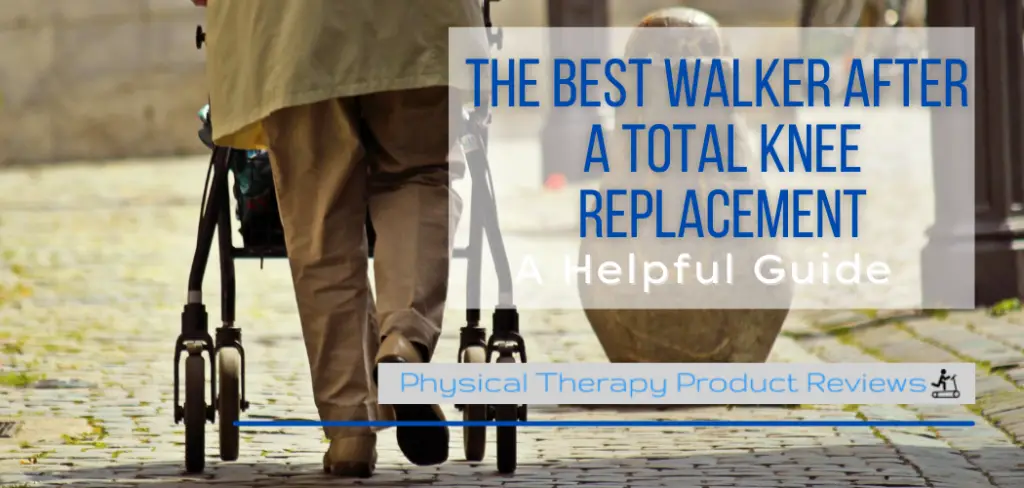
Currently, in the United States, over 600,000 people are undergoing total knee replacement a year. Knee pain is a fairly common symptom in America, especially with the aging Baby Boomer population.
The first total knee replacement occurred in 1968 and since then improvement in materials and surgical techniques have greatly progressed, making a total knee replacement a viable option for those with severe knee pain.
The main reason why a person may choose to undergo a total knee replacement is Osteoarthritis. As the condition worsens and pain increases, the simple act of climbing stairs or even walking may become difficult or even impossible without some form of aid.
Knee pain can even be experienced even while laying down or simply standing. If medications fail to decrease knee pain than most patients will turn toward the surgical option of having a total knee replacement, which has proven to dramatically reduce pain and increase mobility.
Walker for TKA Comparison Table
| Name | Picture | Price | Best Feature | Our rating | Best Price |
|---|---|---|---|---|---|
| OasisSpace Compact Folding Walker |
 |
$ | Tool Free Height Adjustment | 9.6/10 | See Current Price |
| Drive Medical Deluxe Two Button Folding Walker |
 |
$ | Comfortable Vinyl Handle Grips | 9.4/10 | See Current Price |
| Vaunn Medical Two Button Folding Walker |
 |
$ | Detachable sides for compact storage | 9.2/10 | See Current Price |
| Healthline Front Wheeled Walker Folding Deluxe |
 |
$ | Ribbed Rubber Handles for Comfort and Safety | 9.4/10 | See Current Price |
| Drive Medical Heavy Duty Bariatric Folding Walker |
 |
$ | 500 LB Weight Capacity | 9.3/10 | See Current Price |
What Is A Total Knee Replacement?
A total knee replacement can be thought of as “resurfacing” of the working bones of the knee. As arthritis causes degradation and pain, the ends of the Femur and Tibia bones begin to rub on one another. These bones wear out the meniscus, which is the protective cartilage layer between the bones of the leg. Then the bones of the lower leg and upper leg may come into contact with each other and bones spurs can occur as damage to the bone surfaces progresses. Bones spurs are nobs of bone that develop on damaged bone in an attempt to heal.
 During a total knee replacement, metal components are placed on the ends of the femur and tibia bones. In between these metal implants, a strong Polyethylene plastic spacer is placed to help with shock absorption. A plastic “button” is also placed on the backside of the knee cap to help with any arthritis and on the patella.
During a total knee replacement, metal components are placed on the ends of the femur and tibia bones. In between these metal implants, a strong Polyethylene plastic spacer is placed to help with shock absorption. A plastic “button” is also placed on the backside of the knee cap to help with any arthritis and on the patella.
Depending on the manufacturer, the metal implants are typically made from Cobalt-Chromium or a Titanium-Cobalt alloy. The metal compounds are durable, have very few allergic reactions, and are more flexible to work with.
Why Do You Need a Walker After a Total Knee Replacement?
In today’s medical industry, total knee surgeries are progressing towards outpatient surgeries. Meaning that after the surgery the patient will return home to recover, generally in the first-day post-operation.
Currently, most surgeries will stay one to two nights to help monitor pain and complications. However, simply because the patient is able to leave the hospital doesn’t mean the body has recovered.
 The knee is a major weight-bearing joint in the body. Time and proper relief must be given in order for the knee to heal and adjust to the new implants.
The knee is a major weight-bearing joint in the body. Time and proper relief must be given in order for the knee to heal and adjust to the new implants.
During the first couple of weeks, the surgical knee will be swollen and painful, and the patient will most likely not be able to stand or walk on their own without aid.
With the use of a walker, a patient is able to perform most of their house activities. Walkers help provide a stable platform that helps prevent falls and aids in recovery by reducing the amount of weight and stress the knees experience.
The very last thing you want to do is fall because your leg can’t take the load. Falls can cause other broken bones or worse, damage to the new prosthesis.
Does Medicare Cover the Cost of a Walker?
Yes, Medicare does cover the cost of a walker as long as it is deemed medically necessary by an ordering physician. So as long as you get a script you should be covered. You may still have to meet your deductible and if you don’t have a secondary insurance then you would be responsible for 20% of the cost of the walker. However…. read the next paragraph.
Medicare May Not Be the Best Way to Go
This can get complicated. Medicare may only cover the cost of a single durable medical equipment ever 5 years. So if you use your money on a walker now, then that may be the only medical equipment that medicare will buy for the next 5 years. It’s hard to imagine what equipment or health changes might change in 5 years. Also, walkers are really inexpensive so it’s better to buy an inexpensive walker and save your medical reimbursement for when you really need it.
Tips for Using Your Walker after Surgery
When using a walker there are a few tips to ensure that you are using it properly and to the best effect for walking assistance:
- Aligning the feet between the back posts of the walker will ensure proper weight distribution with the device and prevent over or under exertion.
- When gripping the bars with the hands, it is important to have the arms in a relaxed position without putting too much of the patient’s weight on the walker or on the shoulders.
- When in motion with the walker be sure not to put too much weight on the walker, as this can create a lack of stability.
Using a Walker for a Knee Replacement FAQs
You'll use a walker for a minimum of 10 days up to 3 weeks after surgery. The walker helps the knee heal and get back to a normal gait pattern.
A standard walker with wheels on the front and sliders on the back. We typically put tennis balls on the sliders.
We DO NOT recommend using a 4-wheeled walker after a total knee replacement as they do not give you enough support.
No, not immediately after surgery. The risk for falling after a knee replacement is too great and the crutches just don't add enough support.
Walking for the first time with a walker can be challenging. You want to use the walker and put weight through the arms when the surgical limb has weight through it.
Push the surgical leg and the walker forward at the same time.
We like using tennis balls on our walkers. They slider better and still provide good grip outside. It also reduces noise and scraping on the floor.
Simply cut an "X" through the tennis ball and slide it on the foot of the walker.
The Best Front Wheeled Walker after a Knee Replacement
Oasis Space Trigger Release Walker
The Healthline Release Walker is another compact folding model walker. This walker is made with durability and comfort in mind for those patients who may purchase it.
Pros: The Healthline Walker has 5” front wheels that can easily roll over most terrain that a patient most comes across, indoor or outdoor. It comes with two sets of rear post caps and one set of skis in case of damage or loss of a cap in travel.
Cons: The legs of this folder are held in place with an elastic cord so they aren’t able to be switched with newer legs or legs from different walkers.
Drive Medical Deluxe Two Button Folding Walker
The Drive Medical Folding Walker is an aluminum-framed folding walker with front wheels included. This is a basic folding walker that a person would see in many hospital settings. It’s inexpensive, durable, and easy to use.
Pros: The aluminum construction allows for a very lightweight folder that is easy to transport by a single individual. It has vinyl sliders on the back posts to allow for reduced friction when sliding the folder across floor surfaces.
Cons: Due to its lightweight construction heavier patients may cause equipment failure and may need to look for a folder with more durability if looking to use it for a long period of time.
Vaunn Medical Two Button Folding Walker
The Vauun Medical Folding Walker is a standard model walker that a person would see in a hospital or retirement home. It is a long-tested designed and easily affordable for most patients.
Pros: The Vaunn walker is very affordable for the quality of the product. The front wheels can also be moved towards the inside of the front posts to increase mobility when moving inside. This walker can also be adjusted down to 30” for patients shorter than 5’.
Cons: While this walker does fold, it does not fold down to a very compact size. So for those that travel often, it may cause slight difficulty in transportation.
Healthline Front Wheeled Walker Folding Deluxe
The Healthline Front Wheeled Walker is designed for easy use and a larger body builds. It is made with sturdy construction and designed for long term use.
Pros: The release buttons on this folder are located in front of the grips and may be accessed without removing hands from the grips. This allows for ease of use for patients with limited hand function. It also is designed to support up to 350 lbs of weight for heavier set patients.
Cons: This model did not come with a size for patients limited in height. Patients shorter than 5’ may have difficulty operating the folder.
Drive Medical Heavy Duty Bariatric Folding Walker
This is a Bariatric folder from Drive Medical, designed for patients up to 500 lbs in weight. It is designed with heavier duty aluminum and wider stance to allow those patients ease-of-use.
Pros: This walker is heavy-duty, capable of use by patients who otherwise would have difficulty using the average walker. It has a set of wheels on each front post instead of a singular wheel which decreases the exertion felt by the patient in movement. The rear post caps has felt bottoms to prevent scraping and scratching on hard floor surfaces.
Cons: Due to the width of this walker a patient may find difficulty when trying to move through doorways.
In Review
All of the folders listed here are quality pieces of equipment for those who may have had or are looking into, a total knee replacement. By purchasing a walker online you save your medicare money and still save your one assistive device purchase for when you really need it.
Works Referenced:
https://orthoinfo.aaos.org/en/treatment/total-knee-replacement/
r – https://link.springer.com/article/10.1007/s40520-015-0410-8
Effect of uphill and downhill walking on walking performance in geriatric patients using a wheeled walker – https://link.springer.com/article/10.1007/s00391-016-1156-4
Other Great Rehab Related Articles
How to Stay Active After Cervical Fractures: Expert Tips and Advice
Dealing with Painful Stairs After Ankle Replacement Surgery
Walking After a Total Ankle Replacement: Tips for a Successful Recovery
Exercises While Non-Weight Bearing After Ankle Replacement: Elevation, AROM, Leg Raises, and More
Ankle Pain with Stairs: Causes and Home Treatment Options
5 Common Mistakes You’re Making After an Ankle Sprain

Disclaimer: The information provided in this post is for educational purposes only. This is not a substitute for a medical appointment. Please refer to your physician before starting any exercise program.


 Click on Image for More Information
Click on Image for More Information







